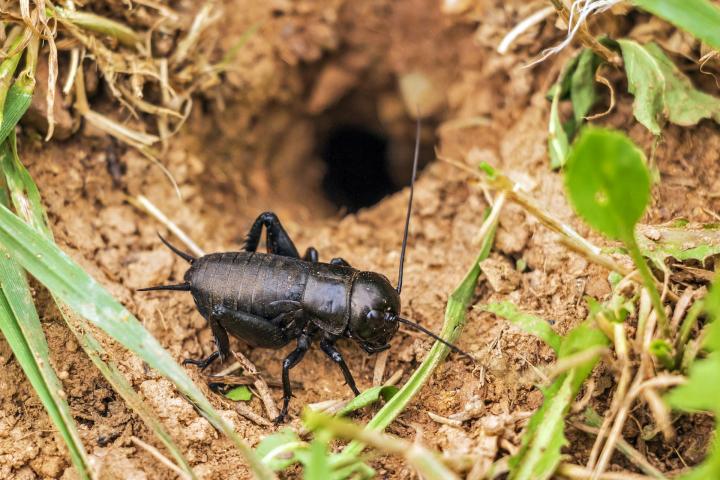How To Clean Cricket Cage
Cricket Facts and Keeping Pet Crickets

Share:
Crickets are fascinating, and observing crickets will teach you a lot about them. They are perfect for children who love insects since they don't bite. Here are some fun cricket facts—and tips for creating a happy atmosphere for a pet cricket in the home or classroom.
Cricket Facts
- Crickets, unlike grasshoppers, are short and stubby, and tend not to jump.
- A fully-grown male is less than an inch long, while the female cricket is about 50 percent longer.
- Insects have a head, thorax and abdomen and six legs.
- Crickets shed their exoskeleton when they need to grow.
- Only male crickets can sing. They don't use their mouth or legs to make the noise but their wings. To sing, male crickets lift their wing casings at a 45 degree angle and rub them together.
- Crickets can sing and eat at the same time. (Can you?)
- Females have an ovipositor (the long stick-like body part at the end of her abdomen); males have two wings and no ovipositor
- The males chirp to find a mate.
- Female crickets lay their eggs in the fall. When they hatch in May or early June there are thousands of tiny black crickets, but by July they are bigger and large enough to start singing.
- The females lay their eggs in damp dirt by pushing their ovipositor into the dirt. They can lay up to approx. 10 eggs a day.
- Like all insects, crickets are cold-blooded. They sing faster or slower depending on the temperature.
Did you know? To convert cricket chirps to degrees Fahrenheit, count the number of chirps in 14 seconds and then add 40 to get the temperature.
Example: 30 chirps + 40 = 70° F
Find out more about using cricket chirps to predict temperature.

Cricket Farms
- In many countries, crickets are eaten! They are farmed and consumed as a high-protein, low-fat snack, boiled in rolling water and sautéed with some salt and olive oil.
- Recently, cricket "flour" has been gaining in popularity, too; it's an expensive, gluten-free, high-protein alternative to wheat flour.
- Yep, those backyard critters have 16 to 21 grams of protein per 100 grams of cricket. An entomologist with the Audubon Nature Institute says, "Crickets provide more than enough protein to fuel the rest of your day. And they contain a good, but not excessive, amount of fat and carbohydrate."
- They're an eco-friendly super food that has more protein density per bite than beef and is chock-full of vitamins and minerals!
- Note: Crickets are are farmed are not bought from pet shops; store-bought crickets are not meant for human consumption based on their artificial feed.
Keeping a Pet Cricket
- A fishbowl or terrarium covered with wire mesh is ideal. Or any glass or plastic enclosure is fine as long as there is proper ventilation (so the insects can breathe) with good air flow.
- Add moist dirt or sand and leaves to the bottom of the jar. A piece of bark can also create a comfortable atmosphere for your cricket. Toilets rolls also allow them to hide.
- Because they'll need a constant source of water, provide a water tray that's shallow enough that they can't drown. You could use the lid of a plastic medicine jar. It can be put in with tweezers or a bacon turner. You can fill the water dish by drawing water through a straw.
- Add a food container; a bottle cap is fine. Crickets need clean food every day. They like most everything, especially raw vegetables such as cucumber as well as grains including granola and oats. They will also need a little protein (tofu, chicken, or even a dog biscuit) or they will start eating each other. You can also buy specifically made cricket food from pet shops. They also like fish food.
- Avoid all pesticides which will kill your cricket. Using insecticides around the home can kill your crickets, too. Put them outside if you're spraying chemicals.
- The best place to catch a cricket is inside your house. In the fall, crickets come inside, attracted by the warmth. You can also buy crickets at a pet shop (they are food for lizards and frogs).
- Once you catch your cricket, wrap him loosely in a handkerchief and transfer him into his jar. We might do this in a glass enclosed shower stall.
- Crickets don't like extreme colds or heats. They prefer a regular temperature of about 86 degrees.
- Clean their home every few days. Always remove any dead crickets. Make sure the food doesn't have any mold on it.
The sad part is, a cricket's life is very short. Typically, if you catch one in good condition in August or September, he should last till about Thanksgiving. When the time comes, bring the jar outside, say your goodbyes, wash and clean it out, and put it away for next fall.
Do you know any cricket facts? Or have you ever kept a cricket as a pet? Let us know in the comments!
What do you want to read next?
How To Clean Cricket Cage
Source: https://www.almanac.com/cricket-facts-and-keeping-pet-crickets
Posted by: lacoursereupok.blogspot.com

0 Response to "How To Clean Cricket Cage"
Post a Comment